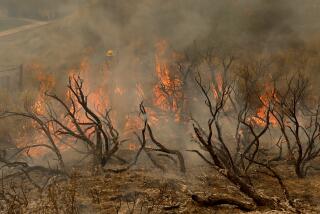Dry Air, Hot Winds Worry Firefighters
The first brush fires of the season offered sobering lessons to fire officials, confirming some of their worst fears about the summer ahead.
The fires in the rolling hills of Riverside and San Diego counties this week hit nearly a month earlier than normal. They were fueled by an unseasonable heat wave, extremely low humidity that allowed flames to catch more quickly, and swirling winds that made the fires hard to follow.
In the San Diego County blazes, roughly 80% of the embers that landed on brush ignited, far higher than the typical ignition rate of 30% to 40% for this time of year, said Kevin O’Leary, a battalion chief in San Diego for the California Department of Forestry and Fire Protection.
The low humidity, which usually comes far later in the fire season, dried out already parched grass, making it tinder for a spreading fire. Humidity is typically 30% to 40% this time of year in Riverside County. When fires on the outskirts of Corona and Temecula started, humidity was less than 7%, said Riverside County Fire Chief Tom Tisdale.
Officials were surprised by how quickly the flames moved even though there were none of the powerful Santa Ana winds that usually spread wildfires. But the lighter, erratic winds of this week proved just as troublesome. Officials worry that these winds will remain a factor until August or September, when the Santa Anas arrive.
Santa Ana winds blow consistently from the northeast. By contrast, the winds this week went southeast for a while, then turned southwest, forcing firefighters to change positions. At one point during the Cerrito fire south of Corona, Tisdale said, the wind was moving in four directions out of Temescal Canyon.
Similarly confusing winds swirled over the Camp Pendleton area when the India fire started on Sunday, said O’Leary. They weren’t as strong as Santa Ana winds, but “they were creating all kinds of turbulence,” he said. “All of a sudden we’d chase it in one direction and then it would turn 180 degrees and run out of another area.”
Tisdale, who has been battling fires in the county since 1971, said he couldn’t remember any other season starting “with quite this vim and vigor.”
“These are August conditions,” he said. “They shouldn’t be around right now.”
Typically during a late spring or early summer fire, firefighters can gain the upper hand fairly quickly, O’Leary said. But the fire this week in Camp Pendleton behaved much differently. It was throwing embers in front of itself, a phenomenon usually seen much later in the fire season.
“Normally you’d get in front of a fire and try to stop it, but this would jump a quarter mile ahead of itself,” he said.
Vegetation was more than ready to burn, he said, because San Diego County had received only about half of its average rainfall. About 40% to 60% of the brush on the hillsides had already died. Even embers that landed on green plants near creeks caught fire, he said.
“That’s pretty extreme,” he added. “What worries us is, what’s it going to be in August or September?”
Even a lot of rain might not help.
“We’re in a five-year drought and we’ve got high temperatures,” Tisdale said. “Even if we had 3 feet of rain, all that would do is flood everything. It wouldn’t soak in. When brush is dead, it doesn’t absorb anything. ... In two or three days, with the wind blowing across it, we’d be back to drought conditions again.”
This week fires finally died down after the heat wave ended and humidity rose.
The Eagle fire that burned east of Temecula was declared fully contained at 6 p.m. Thursday after charring 8,945 acres, according to CDF spokeswoman Dawn Carifi. Meanwhile, the 16,460-acre Cerrito fire that scorched rural hills was due to be fully contained this morning as firefighters initiated their demobilization by retreating out of the county Thursday.
With the fire season starting so early, officials are cautioning people to clear out their property and take care with cigarettes and sparks from off-road motorcycles.
Even in places that have yet to see fire, officials are on high alert. San Bernardino National Forest, for example, will be putting fire restrictions into place today, several weeks earlier than in other years.
Officials who fought the October fires -- the worst in state history -- said they were preparing for a tough battle this fire season.
“Overall, it wasn’t a large piece of San Diego County that burned in the Cedar fire,” said Kelly Zombro, a CDF battalion chief who battled that fire in October.
“A quick drive down Interstate 8 and you can see ... the footprint of the Laguna Fire [from 1970]. There are a couple small places where the path crossed, but in most parts, it never crossed. That footprint is ready to go again.”
*
Times staff writer Lance Pugmire contributed to this report.
More to Read
Sign up for Essential California
The most important California stories and recommendations in your inbox every morning.
You may occasionally receive promotional content from the Los Angeles Times.










